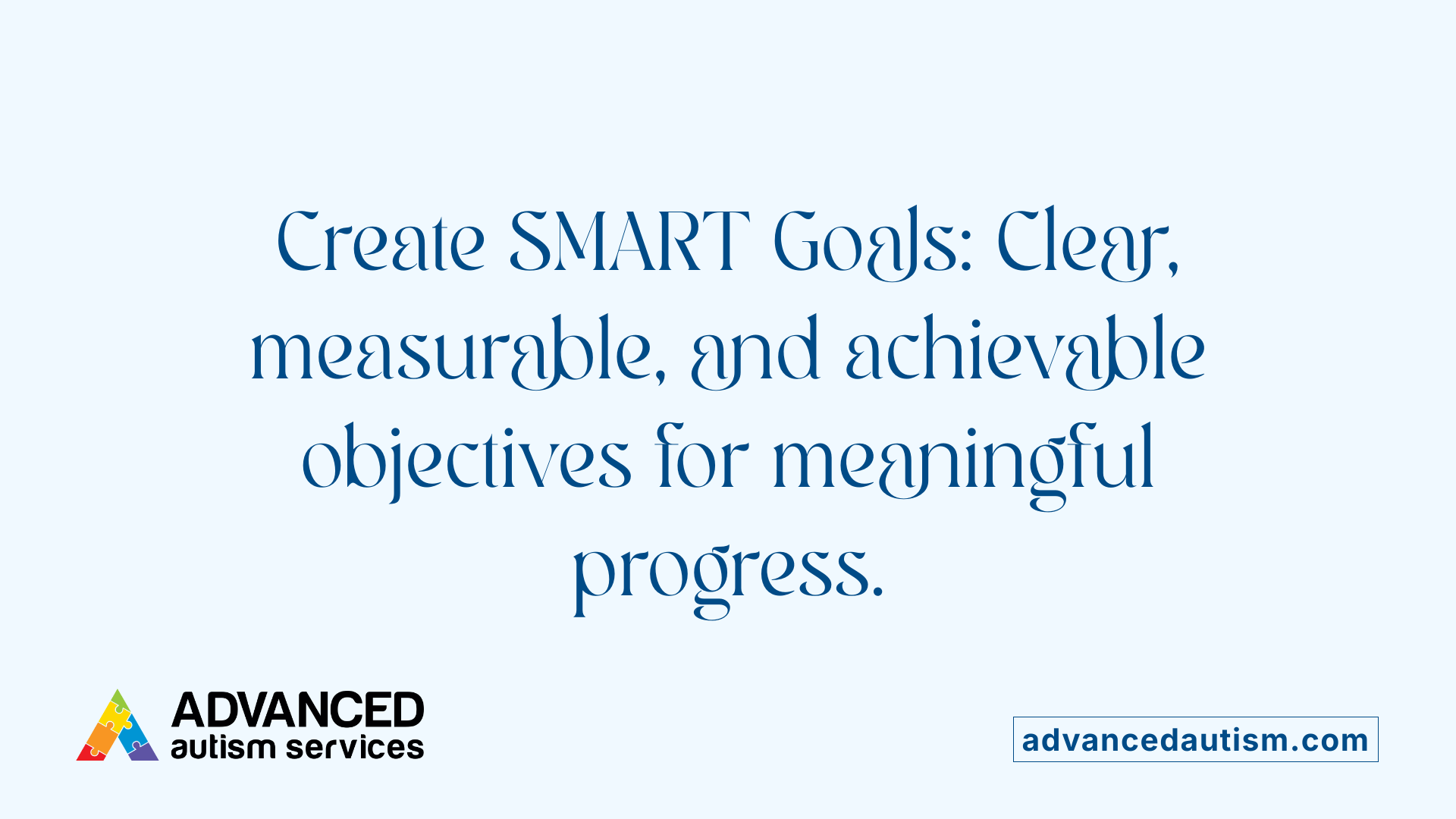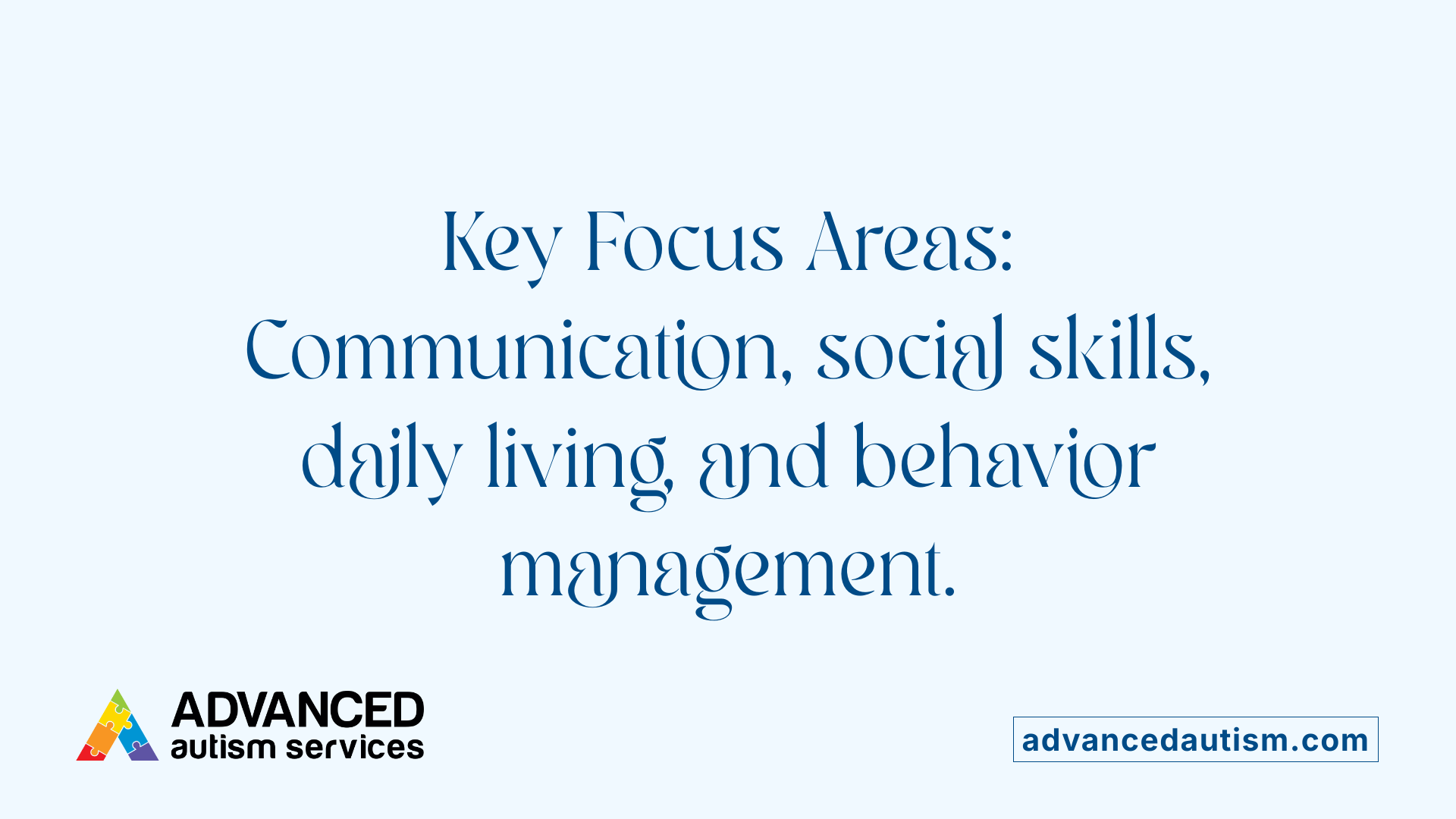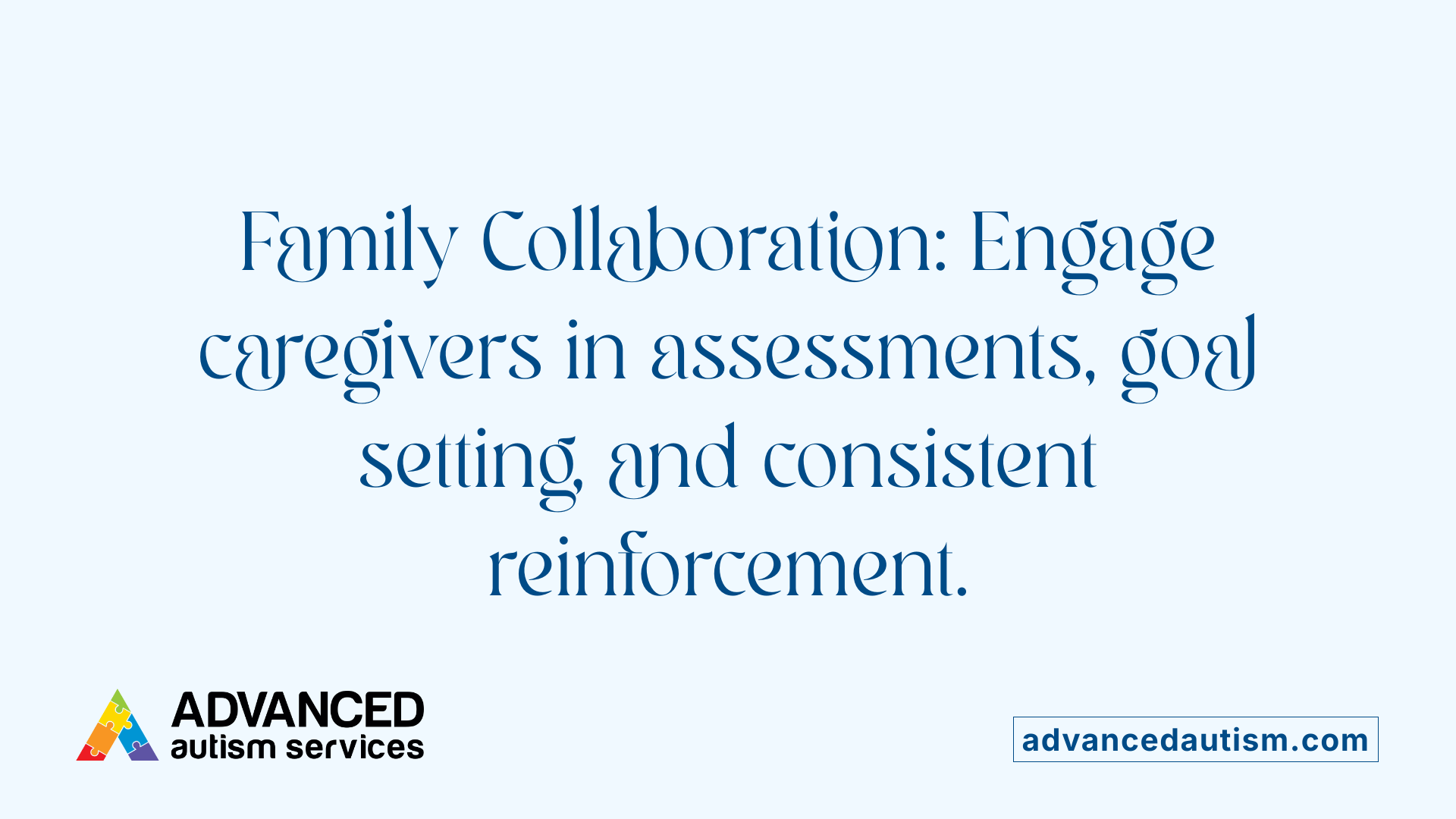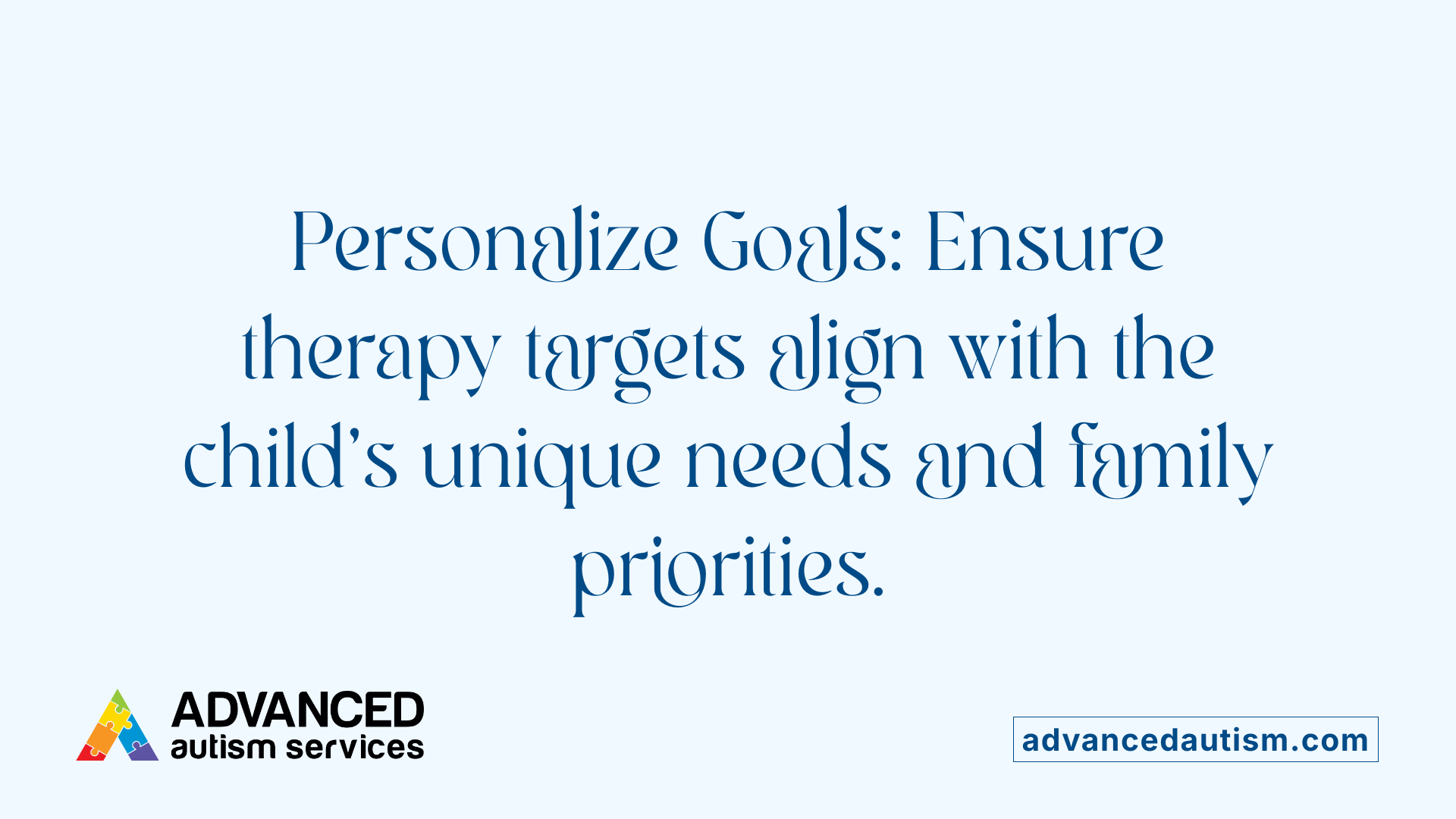How to Set Realistic Goals for ABA Therapy with Your Child
Crafting Effective and Attainable ABA Goals for Your Child’s Development
Understanding the Foundation of Goal-Setting in ABA Therapy
Setting realistic goals in ABA therapy is essential to guide meaningful progress tailored to each child's unique needs. This process involves careful assessment, collaboration among caregivers and professionals, and strategic planning. By establishing clear, achievable objectives, parents and therapists can support the child's growth in communication, social skills, daily routines, and adaptive behaviors—ultimately improving their quality of life.
The Importance of Individualized Assessment in Goal Setting

How do you assess a child's current communication, social, and functional skills?
Assessing a child's current abilities in communication, social interactions, and daily functioning is a crucial first step in ABA therapy. This process involves detailed observations, structured assessments, and collecting data on the child's performance in natural settings. Professionals like BCBA (Board Certified Behavior Analysts) often work closely with parents and educators to gather comprehensive information.
Which tools are helpful for understanding a child's developmental stage?
To accurately evaluate a child's developmental level, several standardized assessment tools are utilized. Commonly used instruments include the VB-MAPP (Verbal Behavior Milestones Assessment and Placement Program), ABLLS-R (Assessment of Basic Language and Learning Skills - Revised), and the Vineland Adaptive Behavior Scales. These tools provide a detailed snapshot of skills across various areas, such as language, social skills, and daily routines.
How do collaboration and assessment contribute to effective goal setting?
Working together with qualified professionals and caregivers helps in developing a thorough understanding of the child's developmental stage. This collaborative approach ensures that goals are realistic, personalized, and aligned with the child's unique needs. Regular assessments also allow for tracking progress, making adjustments, and setting new objectives to promote continued growth.
Strategies for creating effective ABA goals
Effective goal-setting in ABA therapy involves making objectives SMART—Specific, Measurable, Achievable, Relevant, and Time-bound. This clarity helps in tracking progress and maintaining motivation.
Breaking down complex skills into smaller, manageable parts through task analysis makes goals easier to attain. For example, teaching a child to wash hands independently can be broken into recognizing the need to wash hands, turning on the faucet, and drying hands.
Regular data collection during therapy sessions is essential to monitor the child's progress objectively. Reinforcing successes with motivating stimuli, and choosing goals that align with the child's interests, further supports steady advancement.
In summary, thorough assessment and collaboration lay the foundation for individualized ABA goals. Using appropriate tools, understanding the child's current skills, and setting clear, manageable objectives help maximize the effectiveness of therapy and promote meaningful development.
How to Tailor Goals to a Child’s Unique Needs
How can therapists and caregivers establish effective therapy goals tailored to a child's individual needs?
Establishing effective therapy goals in ABA involves a thorough understanding of the child's current abilities. Initially, professionals conduct assessments such as the Functional Behavior Analysis (FBA), along with standardized tools like the ABLLS-R or Vineland Adaptive Behavior Scales. These assessments help identify strengths, challenges, and developmental priorities.
Involving both therapists and caregivers in goal development ensures a holistic approach. Regular collaboration allows for shared insights, aligning goals with the child's daily routines, family values, and cultural background. This teamwork ensures that goals are not only relevant but also meaningful to the child's life.
Goals should be personalized, specific, and measurable, following the SMART framework—making sure they are clear, attainable, and relevant. For example, a goal might be, "The child will respond to their name within five seconds in 80% of trials, measured over two consecutive weeks."
Breaking larger skills into smaller, manageable tasks via task analysis helps prevent overwhelm and fosters consistent progress. Additionally, incorporating the child's interests and preferences into goal setting boosts motivation and engagement.
Regular progress monitoring through data collection and visual trackers enables therapists and caregivers to assess whether goals are being met. Based on ongoing evaluation, goals can be adjusted to better suit the child's developing needs, ensuring continuous growth.
Overall, personalized goal setting in ABA therapy is a dynamic process, rooted in assessment, collaboration, and flexibility, aimed at supporting each child's unique developmental journey.
Principles and Best Practices for Effective Goal-Setting

Creating SMART goals
In ABA therapy, setting goals that are SMART — Specific, Measurable, Achievable, Relevant, and Time-bound — is fundamental for success. These criteria ensure that objectives are clear and attainable, allowing both therapists and caregivers to track progress effectively. For example, a goal might be to improve a child's response to their name within 5 seconds in 80% of trials over a month.
Individualizing objectives based on assessments
Every child is unique, which makes individualization essential. Before establishing goals, thorough assessments using tools like the ABLLS-R, Vineland Scales, or VB-MAPP are conducted. These assessments help identify the child's current skills, strengths, and areas needing support. Consequently, goals are tailored to target meaningful and functional skills that will promote independence and enhance daily living.
Breaking down complex skills
Large or complex skills can be overwhelming for a child. To address this, goals are broken into smaller, manageable steps using task analysis. For example, teaching handwashing might be divided into turning on the faucet, applying soap, scrubbing, rinsing, and drying. This approach makes learning more attainable and allows for easier progress monitoring.
Utilizing data collection for progress monitoring
Regular data collection plays a vital role in ABA goal-setting. Graphs and visual aids help both therapists and caregivers see patterns of progress or setbacks. Consistent measurement enables timely adjustments to goals and strategies, ensuring that intervention remains relevant and effective.
Involving stakeholders
Involving parents, teachers, and other caregivers in goal development fosters a collaborative environment. Their insights ensure that goals are relevant to the child's daily environment and that efforts are consistent across settings. Regular communication and reviews with all stakeholders help keep the goals aligned with the child's evolving needs and priorities.
| Goal Type | Example Objectives | Measurement Criteria | Review Frequency |
|---|---|---|---|
| Skill Acquisition | Respond to name within 5 seconds | 80% success rate over 4 weeks | Monthly |
| Social Skills | Play structured games taking turns | Complete 10-minute game during therapy | Biweekly |
| Self-care | Wash hands independently after restroom use | 4 out of 5 opportunities | Every 2 weeks |
Effective goal setting in ABA therapy hinges on these principles, fostering meaningful progress and motivational success for each child’s unique journey.
Categories of Goals in ABA Therapy and Their Significance

What types of goals and categories are typically included in ABA therapy?
ABA therapy goals are personalized to fit each child's unique needs and developmental levels. These goals fall into several primary categories that address different aspects of growth and independence.
One major area involves improving communication skills. This includes both expressive language, such as using words or gestures to share needs, and receptive language, like understanding instructions or recognizing words.
Social interaction skills are also central. Goals often target behaviors like sharing, taking turns, making eye contact, and engaging in cooperative play. These skills help children connect with peers and adults more effectively.
Daily living and independence are other key areas. Children work toward tasks like dressing, washing hands, and managing personal hygiene, which are essential for independence and self-care.
Behavior management and reduction focus on decreasing problematic behaviors such as tantrums, aggression, or self-injury. Goals aim to replace these behaviors with functional alternatives and improve overall self-regulation.
To achieve these outcomes, ABA employs both structured teaching methods like Discrete Trial Training (DTT) and more natural approaches like Natural Environment Teaching (NET). These methods work in tandem to promote skill acquisition in both controlled and everyday settings.
Goals are developed based on comprehensive assessments, including tools such as the VB-MAPP, ABLLS-R, or Vineland scales. These assessments help identify current abilities and prioritize areas for growth.
Each goal is designed to be specific, measurable, achievable, relevant, and time-bound (SMART). This clarity makes progress tracking easier and helps maintain motivation over time.
In summary, ABA therapy focuses on fostering functional, adaptive skills across multiple domains—communication, social interaction, independence, and behavior—through tailored, measurable steps that support overall development and quality of life.
Step-by-Step Guide to Creating Effective and Measurable Goals
How to conduct thorough assessments before setting goals
Begin by evaluating your child's current skill levels through standardized tools like the VB-MAPP, ABLLS-R, or Vineland Adaptive Behavior Scales. These assessments help identify strengths and areas needing improvement in communication, social skills, daily routines, and behavior. Collaborate with an ABA therapist or behavior analyst who can interpret this data to prioritize target behaviors.
Developing SMART objectives for meaningful progress
Once assessment results are in hand, craft goals that meet the SMART criteria — Specific, Measurable, Achievable, Relevant, and Time-bound. For example, instead of a vague goal like "improve communication," a SMART goal would be "respond to name within 5 seconds in 80% of trials over four consecutive sessions." Clear criteria help both caregivers and therapists track progress effectively.
Breaking complex skills into manageable steps
Large goals can seem overwhelming, so break them into small, manageable tasks. Use task analysis to define each step toward the target skill. For instance, learning to request items might start with the child reaching out, then saying the word for the item, and finally combining gesture and word. Smaller targets make progress achievable and increase motivation.
Collaborating with the therapy team and family
Involve parents, teachers, and the ABA team in goal setting. Their insights ensure that goals are practical, culturally appropriate, and aligned with the child's daily routines. Regular communication and teamwork enable adjustments as the child's needs evolve, maintaining a personalized approach.
Regularly collecting data and reviewing progress
Consistent data collection through frequency counts, checklists, or visual charts provides objective evidence of progress. Schedule regular reviews—every few months—to evaluate whether goals are being met and to decide if adjustments are necessary. Celebrating small successes boosts motivation and reinforces positive behavior.
| Step | Focus Area | Example Goal | Measurement | Time Frame | Additional Notes |
|---|---|---|---|---|---|
| 1 | Assessment | Complete initial evaluation | Use standardized tools | Before goal setting | Ensure comprehensive understanding |
| 2 | Goal Development | Respond to name within 5 seconds | 80% accuracy | Over 4 weeks | Prioritize relevant skills |
| 3 | Break skills down | Request with three words | Step-by-step targets | 2-3 months | Detail each stage |
| 4 | Team collaboration | Weekly team meetings | Meeting minutes | Ongoing | Keep all stakeholders involved |
| 5 | Data collection | Track responses daily | Chart progress | Continuous | Use visual aids to monitor |
Caregiver and Parent Involvement in Goal Monitoring and Support
 Participation in assessments and goal setting is vital for the success of ABA therapy. Caregivers and parents should actively engage in initial evaluations with the therapy team, sharing insights about the child's current abilities, strengths, and challenges. Their input helps behavior analysts set realistic, personalized goals that focus on areas such as communication, social interaction, and daily routines.
Participation in assessments and goal setting is vital for the success of ABA therapy. Caregivers and parents should actively engage in initial evaluations with the therapy team, sharing insights about the child's current abilities, strengths, and challenges. Their input helps behavior analysts set realistic, personalized goals that focus on areas such as communication, social interaction, and daily routines.
Providing ongoing insights and feedback is crucial as the child progresses. Parents and caregivers can observe behavioral changes, difficulties, and successes in everyday settings. Regular communication with the therapy team ensures that goals remain relevant and are adjusted based on the child’s evolving needs.
Implementing reinforcement strategies at home strengthens skill acquisition and encourages positive behaviors. Using preferred toys, praise, or extra playtime as rewards aligns with the child's interests. Consistency in reinforcement across environments helps generalize skills and supports progress.
Tracking daily progress through logs and data collection forms an objective record of improvements. Keeping detailed records of activities, successful responses, and setbacks enables the therapy team to make informed adjustments. Simple daily logs can track behaviors such as response to name, handwashing independence, or play skills.
Involving parents and caregivers in these processes fosters a collaborative approach, creating a supportive environment that emphasizes skill development beyond therapy sessions. Their active participation enhances the child's comfort, motivation, and overall success in ABA therapy.
Aligning Therapy Goals with the Child’s Needs and Family Values

Why is it important to align therapy goals with a child's individual needs and capabilities?
Tailoring therapy goals to a child's unique needs is essential because it makes the goals more relevant and motivating for the child. When goals are personalized, children are more engaged and invested in their progress, which can lead to better outcomes.
Research shows that individualized goals achieve greater success than generic symptom checklists. Customized goals enable therapy to target the child's specific strengths and challenges, improving effectiveness.
Personalized goals also support better assessment and adaptation as the child grows. They foster a stronger relationship between the therapist, child, and family because everyone feels involved and understood.
Involving families in goal setting ensures that therapy aligns with the child's daily routines, cultural values, and family priorities. This collaboration makes goals more meaningful and sustainable, increasing the child's motivation.
By focusing on the child's unique development stage and circumstances, therapists can create flexible, evolving plans that adapt over time. This approach not only enhances the relevance of goals but also encourages continuous progress.
Ultimately, aligning therapy goals with individual needs and family values maximizes the benefits of ABA therapy, helping children learn new skills, reduce challenging behaviors, and develop independence in ways that truly matter to them and their families.
Ensuring Success Through Consistent and Collaborative Goal Setting
Effective goal setting in ABA therapy is a dynamic, collaborative process that hinges on thorough assessment, clear objectives, stakeholder involvement, and ongoing monitoring. By establishing SMART goals tailored to the child's individual strengths and aspirations, families and therapists can foster consistent progress and meaningful development. Regular review, celebrating milestones, and adjusting goals as the child grows ensure that therapy remains relevant and motivating. Ultimately, embracing a personalized and flexible approach maximizes the child's potential, supports their independence, and enriches their quality of life.
References
- ABA Therapy Goals: 25 Practical Examples & Timelines
- How to Set Realistic Goals for Your Child in ABA Therapy
- Charting a Path for Success in ABA Therapy with Goal- ...
- How to Set ABA Goals: A Step-by-Step Guide
- How to Set Realistic Goals as a Family in ABA Therapy
- Setting Realistic ABA Therapy Goals | Childwise
- How to Set ABA Goals: A Step-by-Step Guide
- How ABA principles and effective goal setting can help ...
- Setting Realistic ABA Therapy Goals | Childwise







